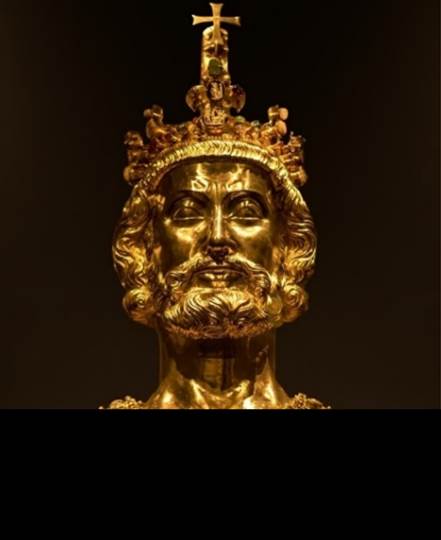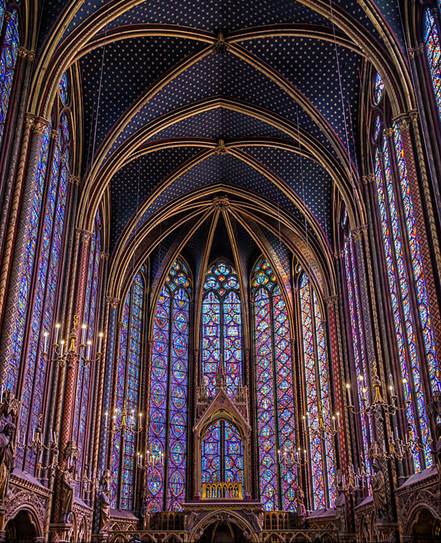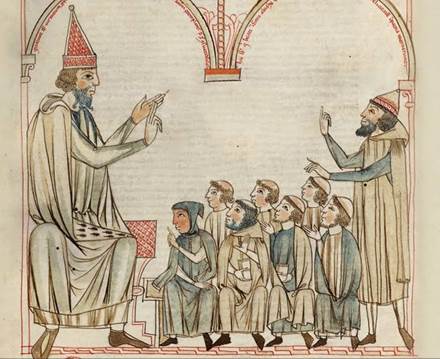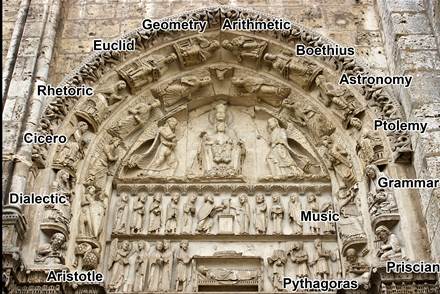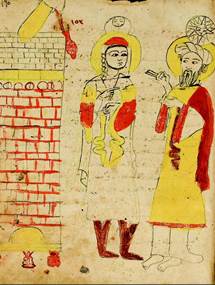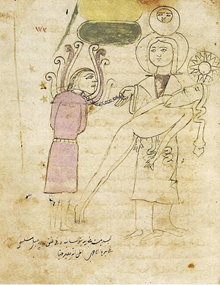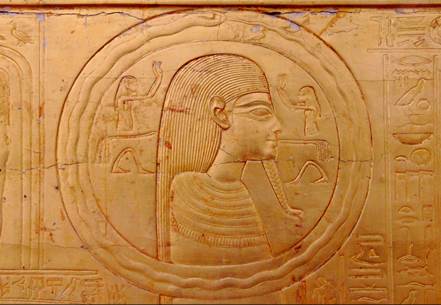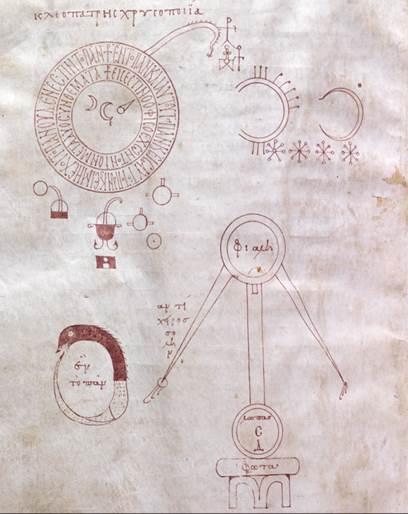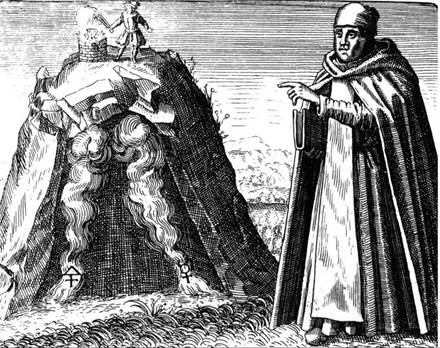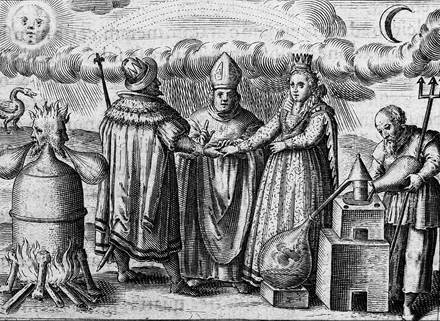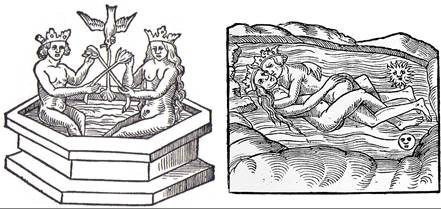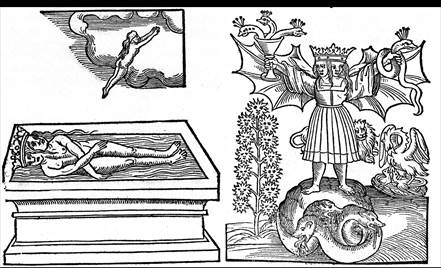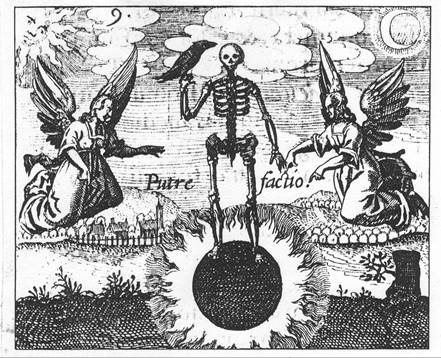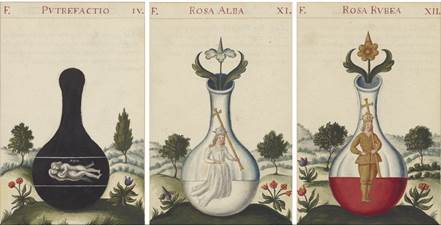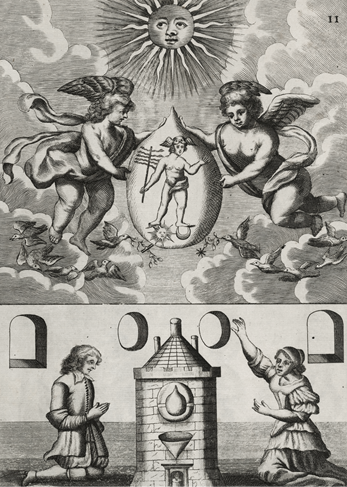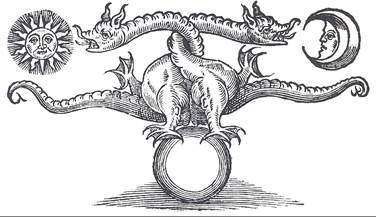The revival of Europe after the fall of Rome took off slowly. It started in the eighth century, when the Frankish king Charlemagne restored the Roman Empire. He unified a large part of Europe and was crowned Roman emperor by the pope.
The revival picked up steam in the 11th and 12th centuries. During this period, known as the 12th century Renaissance, populations boomed, cities were repopulated, majestic cathedrals were built, and many of the major universities of Europe were founded. Intellectual life also began to bloom, especially when Greek and Roman works were translated back from Arabic into Latin. The works of Aristotle had a particularly profound effect, inspiring Scholastic philosophers to bring Christian doctrine in accord with Aristotle’s logic. Aristotle’s emphasis on observation also triggered a renewed interest in science, which laid the groundwork for the Scientific Revolution.
Alchemy was also reintroduced to the West, with as its main goal the creation of the philosophers’ stone, capable of transmuting base metals into gold.
Charlemagne
After the fall of Rome, intellectual life nearly came to a standstill in western Europe. The only remaining bastions of culture were monastic schools, where abbots taught their monks how to read and write, so they could study religious texts and the basics of the liberal arts and copy texts to preserve them for future generations.
Europe began to recover from the fall of Rome in the eighth century during the reign of King Charlemagne (c. 747–814). We know quite a bit about his life because of a biography written by his close confidant Einhard (c. 775–840). Charlemagne was a great leader and military strategist who became king of the Franks in 768 AD. After years of conquest, he managed to expand his kingdom into an empire, which included modern-day France, Germany, and parts of Spain and Italy. After helping the papacy defeat the Lombards in Northern Italy, he was crowned “Charles Augustus, […] emperor of the Romans” [209] by the pope in the year 800 AD, reviving the Western Roman Empire three centuries after its fall.
Fig. 376 – Bust of Charlemagne (14th century) (Pixabay, Thomas Wolter, CC BY-SA 3.0; Aachener Domschatzkammer, Germany)
One of Charlemagne’s greatest achievements was the founding of a palace school at Aachen, which he established in collaboration with the English scholar Alcuin of York (735–804), who received the title “Master of the Palace School” and became responsible for training a generation of scholars, many of whom rose to important ecclesiastical and governmental positions. The school was part community center, part religious institution, part library, and part royal palace. One of the main goals of the institution was to obtain more accurate translations of important religious texts, such as the Bible and the Rule of Saint Benedict, but there was also an attempt to revive classical learning. For instance, Alcuin wrote a work on rhetoric and astronomy. Charlemagne also attempted to raise the general level of education within his empire by issuing an edict stating that every monastery should open a school. Unfortunately, few schools actually opened, but it was a step in the right direction.
After the collapse of the Carolingian dynasty, Germany broke away and established its own successor to the Roman Empire when Otto I was crowned emperor of the Ottonian dynasty in 962 AD. This version of the Roman Empire is often referred to as the Holy Roman Empire and would last for another 900 years.
The 12th-century Renaissance
The revival of Europe truly picked up steam in the 11th and 12th centuries—sometimes referred to as the 12th-century Renaissance. By this time, Europe had just recovered from centuries of raids by Vikings, Arabs, Hungarians, and others. New farming technologies were also developed, greatly increasing the food supply across Europe. Crop rotation prevented the depletion of nutrients in the soil and thereby increased crop yield. The heavy plow was introduced, which was more suited to the Northern European soil than the light Roman plow. The Northern Europeans also began to use the horse for plowing, which is much faster than the ox used by the Romans. To make this work, they also had to develop a new yoke, as the Roman yoke cut off the air supply of horses. The invention of the horse collar solved this problem, making plowing much more effective. Waterwheels were also reintroduced and were used on an unprecedented scale for grinding grain. The climate also helped increase agricultural yield as temperatures were higher between 800 and 1200 AD.
The increased food supply led to a remarkable expansion of the population. It is estimated that between 1000 and 1300 AD, the population of Europe doubled and life expectancy rose by about ten years (in large part due to a lowering of infant mortality). Cities were also repopulated for the first time after the fall of Rome. Around 1000 AD, the largest cities were found in Northern Italy, containing perhaps only 10,000 inhabitants. By 1300, these cities had closer to 100,000 inhabitants. By this time, Germany, France, and England also had cities with about 50,000 inhabitants. Trade also greatly expanded, and the monetary system regained the sophistication of the Roman Empire around 1300. Interest in travel also grew. Marco Polo (1254–1324) even made it to China in the late 13th century and commoners began to undertake long-distance pilgrimages.
Women in the Middle Ages still had few rights, but their position did improve. Unlike in Greece and Rome, women were allowed to hold political power as duchesses and queens (most notably Eleanor of Aquitaine (c. 1122–1204), the duchess of Aquitaine, who married the king of France and later the king of England). A small number of female intellectuals and mystics also had significant influence. It was also not uncommon for women to join the workforce. Only a few professions excluded women from joining.
Fig. 377 – A Christian and Muslim playing chess in Moorish Spain, from The Book of Games (1283) (Royal Academy of Madrid, Spain)
The Arab masters
The increase in prosperity in Europe freed up time for intellectual development. Starting in the 10th century, European intellectuals went to Muslim-ruled Spain, to translate lost works from Greece and Rome back from Arabic into Latin. With the influx of this knowledge, the Europeans were confronted with the overwhelming sophistication of the Islamic civilization and had to admit their inferiority. One of these translators, Daniel of Morley (c. 1140–1210) abandoned his studies in Paris in disappointment and instead traveled to Spain to learn from the Arabs:
[In Paris] I saw beasts seated in scholarly chairs with grave authority. […] But when I heard that the doctrine of the Arabs […] was all in fashion in Toledo in those days, I hurried there as quickly as I could, so that I could hear the wisest philosophers of the world. [194]
Some Europeans even took on Arabic pseudonyms to give their work more credibility (for instance, the pseudonym Geber was used, referring to the Arab chemist Jabir ibn Hayyan).
But the Europeans did not stay behind for long. They were eager to learn and began to translate a staggering number of books. The great English translator and scholar Adelard of Bath (c. 1080–1152) travelled widely, visiting Salerno, Syracuse, Greece, Rome, and even “the Crusader lands” in the Middle East (including the city Antioch in Roman Syria) in order to learn from the Arabs—what he referred to as the “Studia Arabum.” In the Middle East he studied under various Arab mentors, who taught him dissection techniques, basic astronomy and mathematics, taught him how to dye leather, tint glass, and produce green pigment (which he used to create his trademark green cloak and his green signet ring bearing an astrological sign). When in Moorish Spain, he translated many important works on astrology, astronomy, philosophy, and mathematics. Among them was the first full translation of The Elements by Euclid. He also wrote On the Use of the Astrolabe in which he reintroduced Ptolemy’s model of the solar system to Western Europe.
When Adelard returned home, he was the sole person in possession of knowledge that had long vanished from the west. Curious about his knowledge, King Henry II (1133–1189) turned to him for “opinions of the Arabs about the sphere and circles and motions of the planets.” [194] In On the Use of the Astrolabe, Adelard proposed to Henry that his future kingdom should be ruled by a philosopher-king, who is guided by reason. He should be tolerant of all religions and should recognize the authority of the Arabs over the rigid church fathers.
Proud of the knowledge he had collected, Adelard started his work On the Same and the Different with the following line:
When I examine the famous writings of the ancients […] and compare their talents with the knowledge of the moderns, I judge the ancients eloquent, and call the moderns dumb. [194]
And this was no exaggeration. A contemporary European textbook on the abacus, for instance, shows consistent errors in even the most basic calculations. We also have letters from 1025, in which two intellectuals are trying to find out, in vain, what the ancients had meant by the interior angle of a triangle. Also, no European at the time was able to accurately set the date for Easter (the first Sunday following the first full moon after the spring equinox).
In Adelard’s Questiones Naturales, Adelard had an unnamed nephew ask him a series of questions to satisfy his curiosity for “new ideas,” which Adelard then set out to answer using the wisdom of “his Arab masters.” The book covers many topics, including the vegetable and animal kingdom, physics and the heavenly bodies, and even God’s existence. Some of the questions are insightful, while others are remarkably naive, but they all exemplify his endless curiosity. Examples are: “Why are some animals without stomachs?”, “Why do some animals see better in the night than in the day?”, “Why can a man standing in the dark see objects that are in the light, while a man standing in the light cannot see objects that are in the dark?”, “Why are the fingers of the human hand of unequal length?”, “Why the nose is above the mouth?”, “Why can the voice penetrate an iron wall?”, “Why does water not flow out of a narrow vessel with holes at the top and bottom if the upper holes are closed with a thumb?”, “How is the terrestrial globe upheld in the midst of space?”, and so on. Hilariously, he even asked “whether the stars are animate” and if so, “what they might eat.” [210] [211] Finally, he inquired into the existence of God. His nephew asked:
From you then, I want to hear, using reason alone and keeping away from the flattery of authority, whether he exists or not, and what he is and what he does. [194]
But then, Adelard wisely says it’s time for bed, promising to take up the matter of the “beginning of the beginnings” at a later date. But that day, unfortunately, never came.
Crucially, Adelard brought back to Europe the ideal to explain the world as much as possible in naturalistic terms. Only when this method fails, he claimed, should we resort to theology:
We must listen to the very limits of human knowledge and only when this utterly breaks down should we refer things to God. [194]
He also correctly understood the modern scientific ideal of placing reason over authority:
I have learned from my Arabian masters under the guidance of reason. You, however, captivated by the appearance of authority, follow your halter. Since what else should authority be called than a halter? Indeed, just as brute animals are led about by a halter wherever you please, and are not told where or why, but see the rope by which they are held and follow it alone, thus, the authority of writers leads many of you, caught and bound by animal-like credulity, into danger. Whence some men, usurping the name of authority for themselves, have employed great license in writing, to such an extent that they do not hesitate to present the false as true to such animal-like men. 3For they do not understand that reason has been given to each person so that he might discern the true from the false, using reason as the chief judge. For if reason were not the universal judge, it would have been given to each of us in vain. Authority by itself can inspire no confidence in the philosopher, nor ought it to be used for such a purpose. [...] Wherefore, if you want to hear anything more from me, be willing to reason. [210]
The most prolific European translator was the Italian Gerard of Cremona (1114–1187), who moved to Toledo, Spain, which had fallen back into Spanish hands in 1085. He remained there for the rest of his life and translated some 70 works on astronomy, astrology, alchemy, mathematics, optics, philosophy, and logic, including works by Aristotle, Galen, Al-Khwarizmi, Ptolemy, Ibn Sina, and many others. His students wrote about him:
He was trained from childhood at centers of philosophical study and had come to a knowledge of all of this that was known to the Latins; but for the love of the Almagest [Ptolemy’s work on planetary motion], which he could not find at all among the Latins, he went to Toledo; there, seeing the abundance of books in Arabic on every subject, and regretting the poverty of the Latins in these things, he learned the Arabic language, in order to be able to translate. […] To the end of his life he continued to transmit to the Latin world (as if to his own beloved heir) whatever books he thought finest, in many subjects, as accurately and as plainly as he could. [194]
The translator Michael Scot (c. 1175– 1232) took on Aristotle, translating On Animals, On the Heavens, and On the Soul. He also translated several works by Aristotle’s Arabic commentator Ibn Rushd (more on him later). Finally, we mention the Flemish William of Moerbeke (1215–1286), who was encouraged by the famous scholar Thomas Aquinas (1225–1274) to travel to the Byzantine Empire to translate various works by Aristotle from Greek into Latin.
Universities
The influx of new knowledge into Europe also prompted the creation of many new educational institutions. The famous cathedral school of Chartres was founded in 1020 and became associated with some of the brightest scientists of the day. A little later, universities also began to appear. The first formal universities were the University of Bologna (1088), specialized in law, the University of Paris (c. 1150), specialized in theology, and the University of Oxford (1167), which had a broader focus. Traditionally, it was believed that the University of Bologna was founded after the discovery of a 6th-century Byzantine work called The Digest, which summarized Roman law. Although the university did become associated with the revival of Roman law, we now know the university already existed before the discovery as an institute of theology.
Similar to today, students at universities were awarded a Bachelor of Arts after three or four years of study and attained a Master of Arts after an additional two or three years. During this time, students studied seven liberal arts, which included the quadrivium (arithmetic, geometry, astronomy, and music theory) and the trivium (grammar, logic, and rhetoric). The quadrivium had been introduced in the fifth century by the Christian philosopher Boethius (c. 477–524) and dealt with the attainment of knowledge. The trivium was added in the 9th century and dealt with the expression of this knowledge. Boethius translated basic texts on all seven of these topics from Greek to Latin, which were one of the few texts that were widely read during the Early Middle Ages.
After attaining a Master of Arts, a small percentage of students went on to become a Doctor of Law, Medicine, or Theology. Theology was considered the most difficult study and took between ten and sixteen years to complete.
Fig. 378 – Chartres Cathedral (c. 1190 AD). On the right side the nave is held together by flying buttresses (Olvr, CC BY-SA 3.0)
The cathedral
Architecture was also brought to new heights with the Gothic cathedral, which first appeared in 1140 at Saint Denis in Paris. Gothic cathedrals are known for their organic floral look and ceilings with diagonally crossing ribs. Flying buttresses on the outside helped stabilize the building, allowing for greater height and larger windows (see Fig. 380). These windows were filled with beautiful stained glass, which brought different colors of light into the interior (see Fig. 379). Stunningly, between 1170 and 1270, about 80 large cathedrals and about 500 smaller ones were built in France alone. The vastness of this project is a clear indication of the intense religious fervor that permeated the Middle Ages (and also an indication of the incredible power of the Church).
Fig. 379 – The northern rose of the Notre Dame Cathedral in Paris (1250 AD) (Julie Anne Workman, CC BY-SA 3.0)
Fig. 380 – Sainte-Chapelle Cathedral (1248). Notice how the walls are made almost entirely out of glass, yet carry the heavy ribbed ceiling.
Polyphony
The cathedrals also became associated with new developments in music. The Greeks, who had favored the lyre and the aulos (a double flute), already had a strong musical tradition. We know, for instance, that there were famous musicians who played for thousands of listeners and music was also an important topic among philosophers. Pythagoras laid the foundation of music theory, which to him was a manifestation of the order in the cosmos, and Plato and Aristotle discussed the components and effects of music. Aristotle even claimed that music could positively affect one’s character. Generally, the Greeks saw in music the potential to stir great emotions and even to heal the soul.
The Greeks also had a simple form of music notation, but they rarely used it. Only 45 pieces of music (often in fragmentary form) survive from the Greek and Roman Period. The notation consisted of letters to denote pitch, combined with two symbols for the duration of a note. The earliest example is a fragment from Euripides’s Orestes, written in the 3rd century BC. It shows some lines from the play with musical notation above it (see Fig. 382). All the pieces found have in common that they are monophonic, meaning there was only one melodic line which both the instrument and the voice followed, giving it a rather stiff feel from a modern perspective.
Fig. 381 – A satyr playing the aulos (c. 400 BC) (Jean-Pierre Dalbéra; CC BY-SA 2.0; Louvre, France)
Fig. 382 – A musical fragment from Orestes by Euripides (3rd century BC) (Austrian National Library)
Music also played an important role in the early days of Christianity. Jesus is described singing hymns and Paul encouraged early Christian communities to sing “psalms and hymns and spiritual songs.” During the Early Middle Ages, the purpose of music became to connect the listener to the divine and to praise God. To distinguish themselves from the pagans, who used music often as a source of entertainment, Christians limited themselves to a monophonic and relaxing chant without accompanying instruments, known as the Gregorian chant (named after Pope Gregory I (c. 540–604), although it is unclear whether he actually had anything to do with its development). An early example is Ave maris stella (“Hail, star of the ocean”), a hymn in praise of the Virgin Mary, from around the 8th century.
The musical notation we still use today was also developed in the Middle Ages. The earliest versions, from the 9th century, only showed whether notes were ascending or descending, without stating the specific pitch or interval. To play this music, musicians already had to be familiar with the melody. In the 10th century, a horizontal line associated with the note “A” was added, and a century later, a monk named Guido of Arezzo (b. c. 991) used red ink for a line at the “F,” yellow ink for the “C” and scratched the parchment for the notes in between (see Fig. 383). He claimed his notation was sophisticated enough that a singer could “learn a verse himself without having heard it before” (although the duration of notes wasn’t clearly specified yet). This allowed Europeans to preserve melodies in the historical record.
Fig. 383 – Early musical notation from MS 807 (1150 AD) (Universitatsbibliothek Graz, Germany)
Notation also allowed for the development of polyphony, where two different melodies are performed simultaneously, which first developed around 900 AD. Although polyphony existed in other places in the world, musical notation allowed it to be pushed to heights unheard of in previous ages. The earliest form of polyphony was the organum. In the simplest versions, a second voice copies the same melody, but at a higher interval. By the late 11th century, the second voice became more independent and sometimes even moved against the first voice. This style of music peaked around 1150 when a group of composers associated with the cathedral school of Notre Dame in Paris created florid organum, in which one voice sings a simple melody, while a second voice embellishes it with a fast sequence of notes. The result was impressive, purposefully complementing the beautiful cathedral architecture of the time. The school also produced the first medieval composer we know by name, Leonin, who created pieces such as Alleluia pascha nostrum. The school also began experimenting with three independent voices and sometimes also began to include an organ. They also added longs (L) and breves (B) to indicate the duration of notes.
Scholasticism
The High Middle Ages also saw the return of debate. Where monks of the Early Middle Ages were taught not to question the texts they studied (for why question the words of the Lord?), the so-called Scholastic scholars of the High Middle Ages were argumentative and logical. Scholastic teachers would supplement their lectures with disputations, a method inspired by Aristotle in which the topic at hand was looked at from all sides. According to Cicero, Aristotle was the first to practice “disputatio in utramque partem” (“debate on both sides of an issue”), which had the purpose not of winning an argument, but to establish truth. Aristotle also wrote various works on debate, including Rhetoric, the first systematic work on the art of persuasion, Topics, which contains techniques for constructing valid arguments, Sophistical Refutations, which deals with various logical fallacies, and Prior Analytics, which described syllogistic reasoning. The last three of these texts were translated by Boethius in the 5th century, were forgotten, and then reappeared around 1120. These texts were deemed so superior, that their content was describes as “New Logic” (“logica nova”) compared to the “Old Logic” (“logica vetus”) that was available before this date.
Disputations had been popular in Roman days, not just among Greeks and Romans, but also among Christians. For instance, Augustine had engaged in a public disputation with Faustus to refute the Manichean faith (see Fig. 354). But debate disappeared when the Church gained absolute control over religious affairs in the 5th century. As the Church wished to establish itself as the only arbiter of truth, it no longer welcomed debate.
The return of public disputations had to wait until the 11th century. In this century, the economy picked up, giving the population of Europe more headspace to ask questions. This was further stimulated by the return of the works of Aristotle. One of the works that inspired the revival was a worked named Categories (still considered part of the “Old Logic”), which had also been translated by Boethius, but had been lost. The work reappeared in the 10th century when an anonymous translation of the text was found, followed by the actual translation by Boethius in the early 11th century. The leading scholars of the day quickly realized the superiority of the text and were especially mesmerized by Aristotle’s description of the physical universe.
An early proponent of debate was the Italian scholar Lanfranc (c. 1010–1089), who became master of rhetoric and dialectic at the monastery of Bec in Normandy. Ahead of his time, he used debate in his search for a way to harmonize reason and faith. We know he won a disputation against a man named Berengar, wrote a polemic on the matter in the form of a dialogue, and he also reconstructed a debate between Saint Paul and his opponents.
Lanfranc’s student, Anselm of Canterbury (c. 1033–1109), also from Italy, became an even more crucial figure in reintroducing debate and reason in the study of theology. He became the first in a long time to dare mention Aristotle in a theological work and stated in his Monologion a desire to demonstrate Christian truth by “reason alone” (sola ratione).
There may be someone who, as a result of not hearing or of not believing, is ignorant […] about God and His creatures. If so, then I think that in great part he can persuade himself of these matters merely by reason alone—if he is of even average intelligence. Although he can do this in many ways, I shall propose one [way] which I regard as the most accessible for him. [212]
The work starts with the following lines:
Some of my brothers have persisted in asking me to [write] down some thoughts on the divine essence and other related matters, which I have communicated to them in my regular discussions. They asked that nothing should be put forward on the authority of Scripture, and in this I have consulted their wishes […]. They also asked that whatever conclusion was reached in the course of each investigation should be expressed in plain language with intelligible arguments and simple disputation, so that the necessary conclusions and clear truth of the matter would be clearly expressed. [213]
Anselm employed a method of instruction which he consistently called disputatio, in which he encouraged his students to debate an issue for a deeper understanding of the material. This method is exemplified in his Cur Deus Homo, which describes his disputes with his student Boso, who came to him with “perplexing questions.” The active atmosphere in the classroom created by Anselm and his teacher was described by the historian Orderic Vitalis:
The monks of Bec are so devoted to the study of letters, so eager to solve theological problems and compose edifying treatises, that almost all of them seem to be philosophers. [213]
Anselm’s application of his rational method has generally not stood the test of time, but his most famous idea is worth mentioning. In his Proslogion, he gave a famous “proof” of the existence of God. He argued that God is a being none greater can be conceived. He then added that we humans are able to conceive of this concept in our mind. But if the concept exists only in our minds, then we can think of a greater being (namely, one who also exists in reality). But this leads to a contradiction, since we already established that God is the greatest being conceivable, so it must also exist in reality.
Interestingly, his “proof” was attacked already during his own lifetime. A man named Gaunilo wrote a rebuttal named On Behalf of the Fool, since Anselm had written that only a fool could not understand his reasoning. Gaunilo’s criticism was that this argument can be used to “prove” the existence of many things that definitely do not exist. For instance, we can also conceive of a mythical “lost island,” which is the greatest and most perfect island, in our mind, but this doesn’t mean it has to exist in reality.
Anselm countered that an island would only be the greatest conceivable if it could create the cosmos, after which it would no longer be recognizable as an island. So, he claimed, his reasoning only applied to God.
Peter Abelard
Another influential early Scholastic philosopher was Peter Abelard (1079–1142) who was always eager to engage in debate:
I began travelling across several provinces disputing […] wherever I heard that the study of my chosen art most flourished. [213]
Abelard became a skilled debater at a young age and managed to challenge—and often humiliate—many of the leading scholars of his day. In his own words, he had relinquished a potential future in the army “to do battle in disputation.” In his Collationes, he took it upon himself to defend the value of debate in matters of theology, which was still considered heretical by many. He stated that “no debate is so frivolous that it does not teach us something” and claimed logical arguments should be valued over arguments based on authority:
In every clash of disputation truth established by reasoning is more solid than the display of authority. [213]
In a treatise addressed “to an ignoramus in Dialectic,” he defended disputation by reminding his readers that some of the Church Fathers, including Augustine, also debated in order to resolve deep theological questions and to combat heresy. And not just the Church Fathers, “even the Lord Jesus Christ himself refuted the Jews in repeated disputations.”
Daringly, Abelard also produced a document called Sic et Non (“Yes and no”) in which he compared contradicting passages from scripture and the church fathers. The main part of the book opened with:
Here the thoughts are collected from holy writings which seem to be contrary, on account of which this compilation of opinions is called YES AND NO. [214]
The chapter titles in which he names the contradictions are wild. To name a few: “God is not singular or he is,” “God is also the cause and producer of evil or not,” “God knows all things or not,” “Christ did not suffer […] as a human being does or he did,” “James [the brother of Jesus] was the son of Joseph, Mary’s husband or not,” and so on. [214]
In most cases, Abelard listed contradictions between the Church Fathers, or between the Church Fathers and the Bible. For instance, in the chapter “God is also the cause and producer of evil … or not,” he quotes Isaiah, who stated: “I am the Lord and there is no other, forming the light and creating darkness, making peace and creating evil.” He then contrasts this with a quote by Saint Rufinus, who stated: “unless it is good, something is not from God.” In some cases, he also mentions contradictions within Scripture itself. For instance, in the first chapter he quotes Isaiah, stating: “Unless you believe, you will not understand,” but also Psalm 39, which states: “First let me see and so I shall believe.” Later, he writes that in Hebrews it is written that “it is impossible for God to lie,” while in Psalm 134, we read God could do “whatever he wished.”
In the preface to Sic et Non, Abelard wrote that the idea behind his revolutionary method is that questioning can get us to the truth:
By doubting we come to question, and by questioning we arrive at truth. [213]
While his critics believed that theological truth could never emerge from something as earthly and combative as a debate, Abelard countered that to examine a topic with questions, however messy, was often the only way to truly understand the matter.
In the preface to Sic et Non, he further added that he did not wish to denigrate the ancient texts, but instead to “solve [these] controversies” by logical means (although in the main body of the text he simply states the inconsistencies without any attempt to resolve them). In some cases, he claimed, the inconsistencies are simply caused by ambiguities in language and at other times they can be attributed to copying errors, yet about the Bible itself it is “heretical to declare anything departs from the truth. [..] It seems to me it is very destructive to believe something in the holy books is a lie.” Yet, not much later he adds: “even the prophets and apostles were not entirely free of error. […] It is well known that the prophets themselves sometimes lacked the gift of prophecy, and have uttered […] false things.” For instance, he mentioned that Ezekiel claimed that God deceived some prophets and the same Ezekiel also spoke of the sacred value of circumcision, which was later denied by Saint Paul.
To legitimize his endeavor, he noted that even saints such as Augustine acknowledged they made mistakes and were willing to correct them “when the truth was recognized.” Augustine even wrote a Book of Retractions, in which he reread all his works in order to correct and clarify them:
I do not now claim this perfection for myself, when I am an old man; how much less when, as a young man, I started to write.
Augustine also admitted that even scripture could contain errors. In his Reply to Faustus, he wrote:
God forbid that we say that Paul sometimes erred and changed an opinion as he progressed.
Peter also wrote a book on the Trinity, called Theologia Summi Boni, for which he was condemned at the Council of Soissons. The main critique was that he had applied reason in matters of faith. Abelard claimed that his students had desired a rational work on religion. He explained:
It was futile to utter words which the intellect could not possibly follow, that nothing could be believed unless it could first be understood, and that it was absurd for anyone to preach to others a thing which neither he nor those whom he sought to teach could comprehend. [215]
Without reliance on reason, he added, there is no way to counter falsehoods:
How, then, is the faith of any people, however false, to be refuted, though it may have arrived at such a pitch of blindness as to confess some idol to be the creator both of heaven and of earth? [216]
On the shoulders of giants
Around 1150 AD, the translation movement truly picked up steam. More of the major works of Aristotle were reintroduced to the West, including his Metaphysics, which gave a comprehensive explanation of how God created change in the world, based solely on logical arguments. Aristotle’s works also revived the idea that knowledge should primarily come from observation and that reason was the ultimate tool to understand both the universe and God.
Being of pagan origin, the works of Aristotle were rarely read for their own sake. Instead, they were used mainly to gain a more sophisticated understanding of God. The goal became to bring Christian theology in harmony with Aristotle’s rational worldview. This pursuit became the prime goal of Scholastic philosophy.
A century later, these texts were supplemented by works of Aristotle’s most famous Arabic commentator, ibn Rushd (1126–1198), who came from Cordoba, Spain, and was known in the West as Averroes. Together they were referred to as “the Philosopher” and “the Commentator.” To many medieval scholars, their works were only exceeded in importance by the Bible itself.
Ironically, Aristotle’s works became so important they were often considered authoritative, meaning they were uncritically accepted. Just the fact that Aristotle said so, often was enough to convince a scholar of the veracity of a theory. Many Renaissance thinkers would later strongly object to this, although they often went too far, making it seem no medieval thinker ever had a critical thought on Aristotle. This is definitely not true. For instance, the German Scholastic philosopher Albertus Magnus (c. 1193–1280), nicknamed “Doctor Universalis” for being the most learned man of his age, compiled a list of Aristotle’s errors and argued that mere authority was never enough to bring an argument to a successful conclusion. He also stated that “the goal of natural philosophy is not to accept statements from others, but to investigate directly the causes at work in nature.” [40] We will see other examples of medieval freethinkers later in this chapter.
Many medieval scholars did still regard themselves as inferior to the Greek thinkers, although this would slowly change. The beginning of this change can be seen in a quote by the scholar Bernard of Chartres (12th century), who compared the scholars of his days with “dwarfs standing on the shoulders of giants.” John of Salisbury wrote about this:
Bernard of Chartres used to compare us to dwarfs perched on the shoulders of giants. He pointed out that we see more and farther than our predecessors, not because we have keener vision or greater height, but because we are lifted up and borne aloft on their gigantic stature. [217]
This image beautifully combines their huge reverence for the thinkers of antiquity with a modest recognition that they could improve on this heritage (as the dwarfs, however small, could see a little further).
The University of Paris
Inspired by the pioneering work of Lanfranc, Anselm, and Abelard, disputation eventually also became a standardized element of academic training at the University of Paris under the name Quaestiones disputatae. An early proponent of this method was Master Simon of Tournai (c. 1130–1201). His lectures were so popular that even the largest lecture halls could barely contain his audience. He regularly introduced a question to his class, constructed a thesis based on authoritative sources, allowed a student known as the opponens to raise objections against the thesis, and then finally offered the solution. Later masters at Paris also added a respondens, a student who answered the objections.
Fig. 384 – Two university masters engaged in disputation over the Aristotelian definition of happiness. Notice that the students participate. From MS Va 3, 205v (13th century AD) (National Library of Sweden)
In the 13th century, some disputations became open to the general public and sometimes members of the audience were allowed to pick the subject. This type of disputation was often harshly criticized, since the unpredictability of the questions could easily steer the debaters into dangerous heretical territory. Also, the debates, although meant to constructively find truth, often transgressed into cock fights with the contestants “pecking and clawing at each other” (in the words of a chancellor of the University of Paris).
Disputation also found its way out of the universities and became an important skill for members of the Dominican Order. The order was founded in Toulouse by Domingo de Guzman (1170–1221) with the goal of converting heretics (especially the Cathars). To be effective at convincing heretics, the Dominicans taught themselves the skill of disputation. Domingo himself supposedly converted hundreds of Cathars at a time through public disputations, which were presided over by judges. As the order grew and became more international, they received an official order from the pope to “seek out diligently those who are heretics or are infamed of heresy.” Unrepentant heretics were to be burned at the stake.
Disputations in textual form also originated in Paris. An author would pose a series of questions. After each question, he would provide arguments against his own position and then he would refute these arguments. This turned out to be a great way to logically dissect an issue and get to the bottom of it. Peter Lombard (c. 1096–1160), a former student of Abelard, applied this method in his Sententiae, which became a popular textbook intended to give students a summary of all theological knowledge available at the time.
The technique is most famously applied in the Summa Theologiae (“Everything about Theology”) by Thomas Aquinas (1225–1274). Thomas was an Italian Dominican scholar who came to study under Albertus Magnus at the University of Paris. There, he oversaw various disputations, both private and public. Like Abelard, he believed that the use of reasoned arguments was the only way to truly understand a topic, while arguments from authority would leave students with an “empty mind.”
In his Summa Theologiae, Thomas attempted to cover all there was to know about theology and to harmonize Christianity with Aristotle’s rational theory on the universe. The massive work—four times the length of the Bible—covers about 2500 theses combined with 10,000 objections and their rebuttals. To better understand his method, let’s examine the first entry of his work. The first question asks “whether, besides the philosophical sciences, any further doctrine is required [to understand the world]?” [122] Against his own proposition, Thomas argued that “man should not seek to know what is above reason,” which implies that men should not bother with revelation and just stick to the facts. On top of this, he added that it is even possible to argue logically about God, as Aristotle had done in his Metaphysics. Then Thomas presented his counterarguments, noting that “scripture, inspired by God, is not part of the philosophical sciences,” but does contain knowledge necessary for man’s salvation. He left it open whether this knowledge could perhaps also be attained through reason, but even if that were the case, it could be understood only by the greatest geniuses, and therefore would be of no use to the masses.
The Summa Theologiae is rightly regarded as the most ambitious and influential theological text from the Middle Ages, yet writers from the Renaissance generally saw the work as dry and overly logical. The work is hard to read because of its abstract language and the frequent use of jargon and tends to reduce theology to a logical discipline, while Renaissance thinkers were generally more interested in the humane side of religion. They were even harsher in their critique of John Scotus (c. 1265–1308), who in an attempt to improve on the work of Aquinas made even subtler distinctions in jargon (he was even known as the “Subtle Doctor”).
The Summa Theologiae was never finished. In 1273, Thomas Aquinas had a mystical experience that made him abandon his project. When his scribe begged him to continue, Thomas replied: “Reginald, I cannot, because all that I have written seems like straw to me.” [218] He would die only three months later at the age of 50.
The Inquisition
Speaking your mind on theological matters could be very dangerous in the Middle Ages. Until the 11th century, accusations of heresy were limited to isolated cases, but from 1150 onward, the Church felt the need to react systematically to new international movements that began to compete with its official teachings. These movements were sparked by the growing literacy rate, which allowed more people to read the Bible for themselves. In doing so, people started to realize the disconnect between the policies of the Church and the teachings of the Bible. People became especially upset by the corruption and excessive wealth of the Church. An especially persistent group of heretics were the Waldensians, who insisted on the literal interpretation of the Bible and demanded the right for laypeople to read the book for themselves. The Cathars, another influential group of heretics, believed that the material world—including the earthly Church—was corrupt and ruled by an evil God, which they identified with the God from the Old Testament (as opposed to the good God from the New Testament). The Church felt so threatened by the movement that they launched the Albigensian Crusade to wipe them out, slaughtering thousands of members.
In response to these movements, the Church also established the Inquisition. The first inquisition was established in 1184 and required local bishops to investigate their congregations. If heretics were found, the bishops had to reeducate them, but if they refused, they were handed over to the secular authorities for punishment. The institution gained momentum when the Papal Inquisition was established in the 1230s. It was staffed not by bishops, but by full-time professional inquisitors who were appointed by the pope and ran a loose network of tribunals. Trials were conducted in secret, usually with only the inquisitors and the defendant present. The accused could be held for an indefinite time before trial. As of 1252, the inquisitors were also permitted to torture their suspects, although confessions obtained during torture were not legally admissible. Those who confessed were given a penance, such as wearing a yellow cross on their garments, but those who refused to recant or relapsed were handed over to secular authorities to be burned to death.
The condemnations of Paris
Not surprisingly, the Church was also anxious about the influence of Aristotle in the universities. For instance, in 1210, at the Synod of Sens, ten members of a small Aristotelian sect were burned at the stake for believing in pantheism, the idea that God is everywhere. At the same council, it was decided that:
Neither the books of Aristotle on natural philosophy nor their commentaries are to be read at Paris in public or in secret, and this we forbid under penalty of excommunication. [219]
Yet, the curiosity of many scholars was insatiable and they continued to study the forbidden works. As a result, the ban had to be renewed in 1228, when the pope claimed that the Masters of Theology were “committing adultery with philosophical doctrines.” [136] In 1277, the pope banned 219 philosophical and theological theses by Aristotle, Ibn Rushd, and even some by Thomas Aquinas. Among the objections was the belief that God was ignorant of human lives, that God was just one among many gods, and that the world was eternal instead of created. Another common complaint was Aristotle’s overreliance on logic in matters of faith. All of these claims could potentially bring scripture into question.
The great scientists of the Middle Ages
In the rest of the chapter, we will discuss the emergence of science in the Middle Ages. Way ahead of his time, a man named Gerbert d’Aurillac (946–1003), who later became Pope Sylvester II, traveled to Spain to study Arabic manuscripts on mathematics and astronomy. He introduced the West to Indian numerals, the abacus, and the astrolabe, and he is also credited with the invention of the mechanical clock (operated by a weight and a pendulum).
The next significant advances in science had to wait a century or so, when Scholastic philosophers took on the challenge. Their goal became to explain the world in naturalistic terms as much as possible. It was through the laws of nature, they claimed, that God shows his work, which turned physics into a Christian endeavor. In the words of William of Conches (c. 1090–1154), from the cathedral school of Chartres:
It is through knowledge of the creatures that we arrive at knowledge of the Creator. [220]
Many Scholastic philosophers left God with little to do. The English scholar Robert Grosseteste (c. 1168–1253), who studied in Oxford and Paris, even limited God’s direct influence in the world to the first moment of creation. He considered the biblical six days of creation a metaphor and instead believed God only created a single dimensionless point of light. This point of light then radiated outward to form a sphere until it was so diffuse it stopped radiating, thus explaining the spherical shape of the cosmos. Nicole Oresme (1323–1382) compared the universe to an eternal clock. God had made the clock and turned it on, but the rest ran all by itself. We see this mechanistic view of the cosmos also reflected in art, where God was sometimes depicted as a geometer, using a compass to create the world.
Fig. 385 – God as geometer creating the world, from the Codex Vindobonensis (c. 1220 AD) (Austrian National Library)
There were even attempts to explain biblical events in naturalistic terms. For instance, Thierry of Chartres (d. c. 1150) believed that the separation of water in Genesis had been caused by the evaporation of ocean water into clouds caused by heat from the stars (the sun had not yet been created at this point). The evaporation of water, in turn, had created patches of dry land. William of Conches, in his Philosophia Mundi (“Philosophy of the World”), made the same analogy, pointing to the fine mist rising from a hot bath. A fictional opponent in his text then claimed that this mist was now located in a frozen form beyond the fixed stars, supporting itself like a spherical arch. William protested, saying the ice would melt because of the stars and would then fall back to the earth. When his opponent claimed that God could make unmeltable ice if he wanted to, William argued that whoever says God has made anything contrary to nature should either see it with his own eyes or give reasons for it being the case. In the same text, William even went so far as to state that the human body itself was formed by natural means by the action of heat on mud. However, he did believe that God had finally intervened to give man a rational and immortal soul. [19] These opinions made William of Conches subject to accusations by the theologian William of Saint-Thierry, who would also convince the authorities to condemn Abelard to perpetual silence. His main complaint was that William of Conches treated Genesis more as allegory than as fact and that he discussed “God as a physicist.” [40] But the cathedral school of Chartres, known for its dedication to natural philosophy, ignored the accusation. The west door of the cathedral at Chartres even paid homage to the great philosophers of Greece and Rome (see Fig. 386).
Fig. 386 – The west door of Chartres Cathedral, showing the liberal arts depicted as females next to their best ancient practitioners. For instance, Lady Music is depicted with bells and a harp next to Pythagoras, Lady Astronomy is looking upward next to Ptolemy, Lady Geometry is holding a drawing board next to Euclid, and Aristotle is depicted next to Lady Dialectic. In the middle we see at the top Mary with child seated on a throne, below it the circumcision of Jesus, and at the bottom scenes from the birth of Jesus (c. 1220)
The medieval period also saw the return of experimentalists. For instance, Robert Grosseteste conducted experiments on the reflection and refraction of light, and Roger Bacon (c. 1214–1294), who also studied in Oxford and taught in Paris, wrote about magnifying glasses and burning mirrors. Bacon recorded his experiments in precise detail and even described the cycle of observation, hypothesis, and experimentation. According to his Opus Majus, in the section on “experimental science”, knowledge could be obtained by ways of authority, reason, and experience. Of these, he claimed, only experience can give us certain knowledge:
Without experience nothing can be sufficiently known, for there are two modes of acquiring knowledge, namely, by reasoning and experience. Reasoning draws a conclusion […] but does not make [it] certain […] unless the mind discovers it by the path of experience. […] For if a man who has never seen fire should prove by adequate reasoning that fire burns and injures […], his mind would not be satisfied thereby […] until he placed his hand or some combustible substance in the fire. […] Therefore, reasoning does not suffice, but experience does. […] Therefore, he who wishes to rejoice without doubt in regard to the truths underlying phenomena must know how to devote himself to experiment. [40]
The French scholar Pierre de Maricourt (13th century) wrote Letter on the Magnet in which he described a series of experiments with natural magnets, known as lodestones, for which Roger Bacon called him a “master of experiment.” [40] He, for instance, described that a magnet cut in two, produces two magnets, each with its own north and south pole. Interestingly, where other medieval works on science generally make at least some references to religion, this work is entirely secular.
Some thinkers managed to improve Aristotle’s theory of motion, paving the way for the Scientific Revolution. Aristotle believed that a stone thrown upwards continues in its upward motion for a while because of a push from the air that rushes in behind it. In the sixth century, John Philoponus instead concluded that exerting a force on a stone gives it momentum. When thrown upward, this momentum will eventually dissipate by itself, after which the stone would fall down again. He also rejected Aristotle’s claim that heavy objects fall faster than lighter objects. Instead, he concluded that “the difference in time is very small” even for objects “many times heavier than the other.” He did so not by pointing to logical arguments but by actually performing the experiment for himself:
[Aristotle’s view] is completely erroneous, and our view may be completely corroborated by actual observation more effectively than by any sort of verbal argument. [221]
In the Islamic world, Ibn Sina (980–1037) had extended the theory of momentum by stating that momentum could not spontaneously dissipate but only lessen due to external forces, such as air friction and gravity. Jean Buridan (1300–1358) correctly added that the magnitude of momentum (which he called impetus) was proportional to an object’s velocity and mass. Buridan then went on to apply the concept to the planets. They moved eternally not because they were made out of Aristotle’s fifth element but because they had a momentum that would never dissipate since the planets moved in frictionless heavenly spheres. Buridan, however, failed to explain why the planets moved in circular orbits instead of straight lines (this was later explained by Galileo and Newton).
William of Conches even discussed the possibility that the earth was spinning on its axis every 24 hours since this could explain the apparent daily rotation of stars. He did finally conclude that the earth was more likely to stand still since we don’t feel the earth turning and since the element earth was a crude material that would not lend itself easily to movement. To prove the earth didn’t move, he shot an arrow directly upwards on a windless day and noticed it fell back down at approximately the same spot. If the earth rotated, he concluded, the arrow would have lagged behind and fall on a different spot. Nicole Oresme did not find this reasoning convincing. In his Treatise on Heaven and Earth, he claimed to have “several fine persuasions to show that the earth is moved in a daily movement and the sky not.” [222] He correctly concluded that the bow and arrow experiment of Buridan proved nothing since the arrow had been given the momentum of the earth when it was shot upwards and would, therefore, also return to the same spot if the earth was turning. He also explained that objects thrown on a ship moving with a constant velocity fell in exactly the same way as on a ship standing still. From this experiment, he concluded that we cannot detect the difference between standing still or moving with a constant velocity (a discovery that is usually attributed to Galileo). As a result, he concluded that we would not be able to notice the spinning of the earth. But in the end, he, too, couldn’t find any direct evidence that the earth was spinning. Thus, he erred on the safe side and concluded what seemed most self-evident, namely, that the earth was standing still.
Around 1330 AD, a group of thinkers called the Oxford calculators furthered the mathematical description of motion by defining for the first time the notions of uniform velocity (equal distances in equal intervals of time) and uniform acceleration (an equal increase of velocity in equal intervals of time). They also described how to calculate the average velocity of a uniformly accelerating object. Nicole Oresme’s geometric proof of this theorem was later used by Galileo to construct his theory of motion.
The Egyptian origin of alchemy
The medieval translators also made a number of works on alchemy available to Europe. Alchemy has a history going back to Hellenized Egypt in the first centuries AD. The earliest books on alchemy were written by the Egyptian Greek Zosimos, who flourished around the year 300 AD. We know these weren’t the first works on alchemy, since he referred to earlier works that have since been lost, including by a woman named Mary the Jewess. In his text, Zosimos also gives us the earliest mention of the word cheimeia (chemistry), likely related to the Greek word “cheo” (meaning “to melt”). In an attempt to explain the release of fumes during chemical processes, Zosimos hypothesized that all matter is composed of a body (soma) and a spirit (pneuma), which could be separated by fire. The body, he believed, was identical in all matter, an idea that reminds us of Aristotle’s prime matter. Zosimos identified this substance with the liquid metal mercury, an idea that would remain popular with alchemists for centuries to come.
Fig. 387 – Two pages from an Arabic copy of one of Zosoimos’s texts called The Book of Pictures (1211). The image on the left shows Zosimos with his (perhaps fictional) female student Theosebeia next to an alchemical oven. Above their heads, we see the sun and the moon, suggesting they simultaneously represent two chemical substances. On the image on the right, we see Theosebeia holding the deceased body of Zosimos, while holding his escaped soul on a chain, likely representing the release of a fume after a chemical reaction.
The main purpose of alchemy was to transmute ordinary metals into gold, which was called “chrysopoeia,” meaning “gold-making.” Zosimos claimed he knew the recipe, but he conveniently was only willing to reveal it using secretive language. This became a common tactic among alchemists, likely to avoid the fact they actually had no idea how to effectuate a transmutation. To hide their secrets, he wrote, alchemists “call a single thing by many names while they call many things by a single name.” [223] One of his names for the substance that could create gold was the tincture (meaning “pigment”) as it would change the color of any metal into gold. He also used the name xerion, a medicinal powder, since it could “heal” base metals into gold. Zosimos also used the term water of sulfur, a substance made by heating lime, sulfur, and urine, that was used to make silver look like gold. In Greek, water of sulfur could also be read as “divine water.” Only in the seventh century did this legendary substance get to be called the philosophers’ stone.
In his texts, Zosimos also described a number of dreams. In one of them, he is dismembered and burned on an altar until his spirit lifted from his body. He then tells us that these dreams are metaphors for alchemical processes (in this case likely referring to fumes released after a substance was burned). These wild metaphors would remain a common element of alchemical instruction throughout its history.
Alchemists also appropriated an old Egyptian symbol known as the ouroboros, a snake eating its own tail, which had been used at least since the time of Tutankhamun (Fig. 388).
Fig. 388 – Ouroboros on one of the shrines of Tutankhamun (14th century BC) (Djehouty, CC BY-SA 4.0; Egyptian Museum in Cairo, Egypt)
Fig. 389 – The Ouroboros as seen in the Chrysopoeia of Cleopatra in the work called Marcianus Graecus 299 (c. 8th century)
The earliest use of the symbol to represent the alchemical work is found in the one-page work called Chrysopoeia of Cleopatra by Cleopatra the Alchemist, who also predated Zosimos. In Fig. 389, we see her version of the ouroboros. In the middle, we read the words “The All is One,” which again suggests the existence of a prime substance underlying all matter. The snake itself likely represented the cyclical nature of chemical reactions, allowing substances to change from one form to another and back again.
Islamic alchemy
In the Islamic world, “cheimeia” came to be known as “al-kimia,” which later became “alchemy” in the West. Similarly, “xerion” became “al-iksir,” which became “elixir” in Western Europe. According to the historian Ibn Al-Faqih (10th century), alchemical knowledge came to Baghdad after ambassador Umara ibn Hamza (8th century) traveled to the Byzantine emperor in Constantinople. There, he was supposedly shown storehouses filled with bags of white and red powder. The emperor ordered some lead to be melted with a tiny bit of the white powder, which turned the lead into silver. Then he added the red powder to molten copper, turning it into gold. When the ambassador later told this story to Caliph al-Mansur (714–775), he ordered the translation of various alchemical texts into Arabic.
One of the most important alchemists of the Islamic world was Jabir ibn Hayyan. His life is traditionally dated between 720 and about 800 AD, but these dates are highly uncertain. This is in part because the nearly 3000 texts attributed to him were likely written by different authors over various centuries. Jabir took the secrecy of Zosimos to the next level. He claimed he coded his recipes with esoteric metaphors to prevent them from falling into the wrong hands, for his own master, Jafar al-Sadiq, had warned him: “Reveal the knowledge as you desire, but such that none have access to it but those who are truly worthy of it.” [223]
Despite all the secrecy, Jabir did expand our knowledge of chemistry, especially by documenting a large number of chemical reactions, including the creation of aqua regia from sulfuric and nitric acid, which has the power to dissolve gold. He was also an early proponent of experimentation, for which chemistry lends itself exceptionally well. He wrote:
The first essential in chemistry is that you should perform practical work and conduct experiments, for he who performs not practical work nor makes experiments will never attain to the least degree of mastery. [224]
Jabir became especially known for popularizing the mercury-sulfur theory of metals, which would remain influential for centuries to come. Jabir had read about the theory in a ninth-century Arabic text called The Book of the Secret of Creation, written by an author using the pseudonym Balinus (after a first-century Greek philosopher). The basis of the theory went back to Aristotle, who claimed that two exhalations emanate from the center of the earth, one being dry and smoky and the other being wet and steamy (see Fig. 390). Underground, these exhalations condense, producing the different metals. Pseudo-Balinus claimed that mercury was related to the moist exhalation and sulfur to the smoky exhalation. Different combinations of mercury and sulfur would create the various metals, and just the right combination would produce gold. Since this process was believed to occur naturally in nature, it seemed reasonable to assume it could be replicated in the lab. Since hot and wet were believed to dominate in gold and cold and dry in lead, Jabir believed that turning lead into gold simply involved introducing more hot and wet or reducing cold and dry. But since any material contained a combination of the four qualities, gold could, in principle, be made from all substances. Remarkably, alchemists already knew that mercury and sulfur combined into a red mineral called cinnabar, which isn’t even a metal. But Jabir claimed that the words mercury and sulfur were just codenames for some other, more mysterious substances.
The text by pseudo-Balinus also contains the earliest copy of the Emerald Tablet, which was probably written in the eighth century. Balinus claimed to have found a tablet made of green stone, clenched in the hands of an ancient corpse buried in a tomb beneath a statue of a man named Hermes Trismegistus (“the Thrice-Greatest”). Hermes was believed to be the author of the Hermetic Corpus, a set of Greek texts from the second century that dealt with mysticism, but over time came to be associated with alchemy (likely because the Roman equivalent of the Greek god Hermes was the god Mercury). By the 10th century, Islamic alchemists considered Hermes Trismegistus the founder of alchemy (and later, in the West, he was also considered a contemporary of Moses who had foretold the coming of Christ). Consequently, alchemy came to be known as the Hermetic art. The Emerald Tablet became hugely influential among alchemists as it was believed to contain the secret of the philosophers’ stone. Cryptically, it reads:
Truth! Certainty! That in which there is no doubt! That which is above is from that which is below, and that which is below is from that which is above, working the miracles of one thing. As all things were from one. Its father is the Sun and its mother the Moon. The earth carried it in her belly, and the wind nourished it in her belly, as earth which shall become fire. Feed the earth from that which is subtle, with the greatest power. It ascends from the earth to the heaven and becomes ruler over that which is above and that which is below. [225]
The Islamic world also had a number of significant critics of alchemy. Among them was Ibn Sina, who denied the possibility of transmutation, claiming that alchemists do “not have the power to bring about any true change of species.” He wrote:
Whatever God created through natural powers cannot be imitated artificially; human industry is not the same as what nature does. [223]
Fig. 390 – The formation of metals in a text by Michael Maier. The two exhalations in the earth are depicted. A closer look also shows the astrological symbol for mercury and sulfur. An accompanying text reads: “Just as nature produces metals from sulfur and mercury, so too does art [alchemy]” (Memorial Library of Wisconsin, PD)
Fig. 391 – A marriage representing a chemical reaction in the laboratory from The Sixth Key of Basil Valentine (1618). Notice how a divine spectacle is depicted next to the crude work of the alchemist.
A later Latin author rightfully refuted this claim since substances like salts could be made in the lab and seemed identical to salts found in nature.
The Arabic sources also give us the first stories about charlatan alchemists, who used tricks to pretend to make gold. They put false bottoms in their crucibles or hid gold in hollow implements. We also read of alchemists who asked their patrons for gold, which they claimed was necessary to produce much more. Not surprisingly, they then ran off with it.
Fig. 392 – A king eating his own son representing a chemical reaction. The god Mercury is standing on the side. From De lapide philosophico by Lambsprinck (1677)
Fig. 393 – Images from the Rosarium Philosophorum (1550 AD). The first two images depict the union of sun and moon. In the third image, we see a soul departing, representing distillation. When the soul returned, the philosophers’ stone was formed, here depicted as a hermaphrodite trampling on the mercurial dragon representing prime matter.
The rose garden of the philosophers
The first alchemical texts arrived in Europe in the 12th century. A century later, Western alchemists began to write their own works. An important early work was written under the pseudonym Geber, which was the Latinized version of Jabir. Geber gave an interesting account of the differences between metals. He assumed that gold was made out of smaller parts that were tightly packed together, while other metals were packed in weaker arrangements. This allowed him to explain why gold is heavier than other metals. It also explained why it isn’t corrosive, as flames couldn’t penetrate such a tightly packed lattice of particles.
Surprisingly, the earliest Western texts were written in a straightforward language, but this changed in the 14th century, when the metaphors became even more complicated than before. The flight of a dove might symbolize evaporation, as did the departure of a soul from a body. A potent reaction between two chemicals might be described as a marriage between a king and a queen (see Fig. 391) or a king eating his own son (see Fig. 392). The reader was left guessing which substances these metaphors referred to.
Pseudo-Arnald of Villanova (14th century), in his work Tractatus Parabolicus, became the first to use Christian metaphors to describe chemical processes. For instance, he compared the torments of Christ on the cross with the torments of materials in the crucible. Similarly, he compared the resurrection of Christ with the transmutation of mercury into the philosophers’ stone, and he compared Christ’s role as savior of mankind with the “saving” of base metals by turning them into gold. Petrus Bonus (14th century) even went as far as to claim that alchemical processes could reveal theological truths. For instance, he believed that ancient philosophers had predicted the virgin birth in their crucible. In a similar vein, he wrote:
I believe firmly that should any unbeliever truly know this divine art, it would of necessity make him a believer in the Trinity of God, and he would believe in Jesus Christ our Lord, the Son of God. [223]
The famous alchemy books filled with mysterious images only appeared in the late Middle Ages. The earliest of these is probably the Rosarium Philosophorum (“Rose-garden of the Philosophers”). The 14th-century original contained no images, but in 1550 AD, it was combined with images inspired by two early 15th-century German works called Sun and Moon and The Book of the Holy Trinity. According to the text, the philosophers’ stone could be created by combining two substances, which they referred to as sun and moon, king and queen, or sulfur and mercury. Following the mercury-sulfur theory, these opposites were combined to form the stone, which was symbolized by a hermaphrodite (see Fig. 393). Mysteriously, the text added that the gold made from the stone was “not common gold,” but a more mysterious alternative.
Over time, a relatively stable recipe crystalized in the alchemical texts for the creation of the stone. At first, a number of substances (about which the texts disagreed) were placed in a glass vessel with an oval body and a long neck. This flask was called a philosophical egg (ovum philosophicum), referring both to its shape and its function of “giving birth” to the stone. The opening in the neck was melted shut to prevent the loss of gases, which came to be known as the hermetic seal. The egg was then placed in a furnace for many weeks until the substance turned black. This stage is referred to as putrefaction (“rotting”) or nigredo (“blackness”), and the furnace in this stage was often compared to a tomb or coffin (see Fig. 394). Common images associated with this stage are the crow, the death of a king, and the god Mercury in the form of a dragon (sometimes eating its own tail). During this process, matter was decomposed into its most basic form, often identified with Aristotle’s prime matter.
Fig. 394 – The alchemical stage called putrefactio by Johann Daniel Mylius (1622)
Fig. 395 – The black, white, and red stage of alchemy, from the Pretiosissimum Donum Dei (17th century) (Bibliotheque Nationale de France)
Over time, the blackness disappeared and made way for a number of changing colors known as the cauda pavonis (“peacock’s tail”). Next, a white stone appeared, which was said to be able to transmute base metals into silver. This phase was often called albedo (“whiteness”). By turning up the heat, the white material turned yellow and then a red stone was formed, a stage known as rubedo (“redness”). This stone was the legendary philosophers’ stone that could turn base metals into gold (see Fig. 395). At this stage, the image of Mercury was again often used, but now in human form.
Authorities had a love-hate relationship with alchemy. On the one hand, the idea of endless gold was appealing, causing several kings to employ alchemists in their royal courts. But alchemists also created huge amounts of imitation gold, which caused high inflation, leading to economic collapse. As a result, Pope John XXII (1244–1334) felt compelled to issue a decree banning alchemical gold. We read:
The impoverished alchemists promise riches that they do not deliver, and they who think themselves wise fall into the ditch they have dug. For indeed the professors of this art of alchemy make fools of one another. […] Finally, though there is no such thing in nature, they pretend to make genuine gold and silver by a false transmutation. [223]
The decree, however, was largely ignored, even in holy orders.
The promise of limitless gold made various alchemists targets of criminals, at least according to their own stories. We have various anecdotes of bandits forcing alchemists to reveal their secrets. In the Rosarium Philosophorum we read: “Not a few have perished in our work.” George Starkey (1628–1665 AD), writing under the pseudonym Eirenaeus Philalethes, told the following story:
It was only a short time ago that, after visiting the plague-stricken haunts of a certain city, and restoring the sick to perfect health by means of miraculous medicine, I found myself surrounded by a yelling mob, who demanded that I should give to them my Elixir of the Sages; and it was only by changing my dress and my name, by shaving off my beard and putting on a wig, that I was enabled to save my life, and escape from the hands of those wicked men. […] I know of several persons who were found strangled in their beds, simply because they were suspected of possessing this secret, though in reality, they knew no more about it than their murderers; it was enough for some desperate ruffians, that a mere whisper of suspicion had been breathed against their victims. [226]
Paracelsus
The connection between alchemy and medicine was made explicit by the influential alchemical doctor Theophrastus von Hohenheim (c. 1493–1541), better known as Paracelsus. Paracelsus had little interest in creating gold and instead saw the potential of alchemy to cure diseases. He also developed what he called a chemical worldview, in which he envisioned God as a master chemist. The cycle of rain through sea, air, and land, he believed, was nothing more than God’s cosmic distillation. The formation of minerals underground, the growth of life, and internal processes such as digestion all pointed to complex chemical processes. God’s final judgment by fire, he believed, will be similar to an alchemist using fire to purify metals.
Paracelsus also claimed that chemistry could be used to create life. This had also been an obsession of Jabir ibn Hayyan, who wrote several recipes for creating scorpions, snakes, and even human beings who would become subject to their creator. Paracelsus claimed he could make a human-like creature, which he called a homunculus (“little human”), by putrefying semen and feeding it with blood. Although it looked like a human child, he claimed it was endowed with great knowledge and powers, partly, he claimed, because it lacked female ingredients.
Fig. 396 – Two alchemists praying while the philosophers’ stone in the form of Mercury descends (1677) (Library of Congress, PD)
The appeal of the stone
Historically speaking, the study of alchemy is of great interest precisely because it is obviously erroneous yet consumed the minds of some of the greatest thinkers from world history. Even Isaac Newton and Robert Boyle, as we will read in a later chapter, were obsessed with it. How could those great minds have fallen for such an obvious scam? First of all, the major texts were written by respected authorities. When these authors claimed they used coded language to avoid bad actors from getting to the truth, this was not just believed without question, but made the serious student of alchemy feel he was just one insight away from being part of a select group of gifted initiates. Any failure to produce the stone, was understood to mean the practitioner didn’t yet fully grasp the meaning of the texts. Various recipes also required prayer and a pure soul. In the book Mutus Liber, for instance, we read, “Pray, read, read, read again, and you shall find.” In the same book, we find an image of an alchemist in prayer before his furnace, while two angels bring down the stone from heaven (see Fig. 396). A failure to produce the stone could, therefore, also be explained away by a lack of sincerity.
Another convincing factor were testimonies by authoritative alchemists. A famous case was Nicolas Flamel (c. 1330–1418), who was a wealthy scribe and philanthropist from Paris. Although he might not even have been an alchemist, a legendary account of his life began to pop up in the 17th century, in which it was claimed that he had deciphered an alchemical text, which allowed him both to create the stone and also an elixir of immortality (with some writers claiming he was still alive). Newton also fell for this story. Hilariously, the success stories of legendary alchemists creating the stone generally ended with the stone getting lost or used up. Others were scam artists who gave “demonstrations” of the stone by secretly putting gold in their crucibles or by producing imitation gold.
Finally, some part of the alchemical theory was genuinely convincing. Since metals can be found in the ground, it seemed sensible to assume they could also be created in the lab. Also, the alchemists witnessed truly remarkable chemical transformations on a daily basis in their labs, not to mention the mystery of seeing a seed turn into a tree or an embryo into a human being. Transmutation seemed to exist all around them. Why would it not be possible to create gold?
Fig. 397 – The Mercurial dragon converting
prime matter (depicted below) into gold (the sun) and silver (the moon) from
the Theatrum Chemicum Britannicum by Elias Ashmole (1652)

